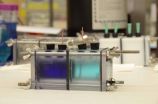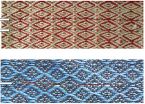(Press-News.org) LA JOLLA, CA--December 3, 2014--A team led by biologists at The Scripps Research Institute (TSRI) has solved a long-standing mystery in neuroscience by identifying the "mechanoreceptor" protein that mediates the sense of touch in mammals.
Mice that lack the Piezo2 ion-channel protein in their skin cells and nerve endings lose nearly all their sensitivity to ordinary light touch, but retain a mostly normal sensitivity to painful mechanical stimuli.
"We can say with certainty that Piezo2 is the principal touch sensor in mammals," said Ardem Patapoutian, professor at TSRI and investigator with Howard Hughes Medical Institute.
Patapoutian and his colleagues report their discovery in the December 4, 2014 issue of Nature.
Unraveling the Clues
By the 1980s scientists have known the identity and sequence of the main protein photoreceptor that underlies the mammalian sense of sight. Since the early 1990s they have been identifying smell and taste receptors. But the mechanoreceptor protein that mediates the sense of touch has been more elusive. "It works in very few specialized cells and isn't abundant in those cells," Patapoutian said, "and at the start we didn't have many clues about what it would look like."
Four years ago, with the help of advanced genomics techniques, Patapoutian and members of his laboratory were able to identify two mechanically activated ion-channel proteins, Piezo1 and Piezo2, in mouse cells. Physical force, enough to distort a cell membrane in which one of these ion channels was embedded, could effectively switch the ion-channel from closed to open, allowing sodium or other positively charged electrolytes to flow inward. In a sensory nerve, that could trigger an electrical nerve impulse--thus tranducing physical force into a neural signal.
Of the two newly identified ion-channel proteins, only Piezo2 was expressed significantly in the touch-sensing neurons that are based in the dorsal root ganglia of the spine and extend their nerve processes into the skin. That led Patapoutian to focus on it as the likely transducer for the mammalian sense of touch.
Last year, Patapoutian and colleagues reported that Piezo2 works as the touch sensor on Merkel cells, specialized cells that lie at touch-sensitive nerve terminals in the skin and augment the sense of touch in mice.
One Ion Channel for One Type of Touch
In the new study, the researchers extended these findings to the touch-sensitive nerve terminals themselves. These are often shaped to detect different types and directions of force, and for extra sensitivity may be attached to other force-responsive structures such as Merkel cells or hair follicles.
To start, the scientists made use of special mice, bred in the earlier Merkel cell study led by postdoctoral fellow Seung-Hyun Woo, which produce Piezo2 linked to a fluorescent protein. That allowed them to verify, via the resulting fluorescence, that Piezo2 is expressed in a broad range of "low-threshold mechanoreceptor" nerve terminals, which are embedded in both hairy and hairless areas of mouse skin.
The next step was to delete the Piezo2 gene from mice and observe whether the animals still responded normally to touch stimuli. But mice bred without Piezo2 all died at birth. Thus, postdoctoral fellow Sanjeev S. Ranade, lead author of the paper, had to accomplish the tricky task of developing a "conditional knockout" mouse line, in which the Piezo2 gene could be almost completely deleted from already-mature mice, and just from their dorsal root ganglia sensory neurons and Merkel cells.
Electrical tests of these neurons cultured from the mice, performed by staff scientist Adrienne Dubin, showed that they lost virtually all the responsiveness to mechanical stimuli that would be required for sensing ordinary light touch. Collaborator Gary Lewin and members of his laboratory at Berlin's Max-Delbrück Center for Molecular Medicine found the same profound loss of mechanosensitivity in special tests of intact skin nerves from the mice.
The mice lacking Piezo2 in their nerve endings and Merkel cells also showed a clear behavioral difference from normal mice. "Across a range of tests, we observed a dramatic reduction in their responsiveness to ordinary light touch stimuli," said Ranade.
Remarkably, these touch-insensitive mice remained responsive to skin-applied stimuli that are normally painful, such as heat, cold and pinching. Painful mechanical sensations such as pinching are thought to be mediated by high-threshold mechanoreceptor nerve terminals, which require more force to activate. "The functions of these high-threshold mechanoreceptor nerves seemed unaffected in the Piezo2 conditional knockout mice," Patapoutian said.
The finding suggests that the detection of light, innocuous touch--which we commonly think of as the "sense of touch"--is mediated principally by one set of nerve ends using piezo2 ion channels. By contrast, stronger, pain-causing touch sensations appear to be mediated by a less force-sensitive set of nerve ends with their own ion channel proteins, which have yet to be discovered.
Potential Applications
Patapoutian now plans to investigate how much "crosstalk" exists between these two mechanosensitive nerve systems. It is well known that chronic pain conditions can make even light touch stimuli feel painful. "This discovery now allows us to test the relationship between touch and pain," he said.
He and his colleagues also are investigating the role of Piezo2 in other parts of the body where it is expressed, including the lungs.
INFORMATION:
Other contributors to the paper, "Piezo2 is the major transducer of mechanical forces for touch sensation in mice," were Seung-Hyun Woo, Adrienne E. Dubin, Bertrand Coste, Allain G. Francisco and Kritika Reddy, all from TSRI during the study; Rabih A. Moshourab, Christiane Wetzel and Valérie Bégay, of the Max-Delbrück Center for Molecular Medicine; Zhaozhu Qiu, Matt Petrus, Jayanti Mathur, James Mainquist and A.J. Wilson of the Genomics Institute of the Novartis Research Foundation, San Diego, California; and John N. Wood of University College, London.
Funding for the research came partly from the National Institutes of Health (R01 DE022358).
Researchers from the African Genome Variation Project (AGVP) have published the first attempt to comprehensively characterise genetic diversity across Sub-Saharan Africa. The study of the world's most genetically diverse region will provide an invaluable resource for medical researchers and provides insights into population movements over thousands of years of African history. These findings appear in the journal Nature.
"Although many studies have focused on studying genetic risk factors for disease in European populations, this is an understudied area in Africa," says ...
ROSEMONT, Ill.--Compression fractures in the spine due to osteoporosis, a common condition causing progressive bone loss and increased fracture risk, are especially common in older women. A new study appearing in the December 3rd issue of the Journal of Bone & Joint Surgery (JBJS) found that patients who wore a brace as treatment for a spinal compression fracture had comparable outcomes in terms of pain, function and healing when compared to patients who did not wear a brace.
Nearly 700,000 men and women suffer from a spinal compression fracture each year. These fractures, ...
People who work around the clock could actually be setting themselves back, according to Virginia Tech biologists.
Researchers found that a protein responsible for regulating the body's sleep cycle, or circadian rhythm, also protects the body from developing sporadic forms of cancers.
"The protein, known as human period 2, has impaired function in the cell when environmental factors, including sleep cycle disruption, are altered," said Carla Finkielstein, an associate professor of biological sciences in the College of Science, Fralin Life Science Institute affiliate, ...
The more time you spend getting to and from work, the less likely you are to be satisfied with life, says a new Waterloo study.
Published in World Leisure Journal, the research reveals exactly why commuting is such a contentment killer--and surprisingly, traffic isn't the only reason to blame.
"We found that the longer it takes someone to get to work, the lower their satisfaction with life in general," says Margo Hilbrecht, a professor in Applied Health Sciences and the associate director of research for the Canadian Index of Wellbeing.
While commuting has long been ...
Is your inbox burning you out? Then take heart - research from the University of British Columbia suggests that easing up on email checking can help reduce psychological stress.
Some of the study's 124 adults -- including students, financial analysts medical professionals and others -- were instructed to limit checking email to three times daily for a week. Others were told to check email as often as they could (which turned out to be about the same number of times that they normally checked their email prior to the study).
These instructions were then reversed for ...
RIVERSIDE, Calif. - Geckos, found in places with warm climates, have fascinated people for hundreds of years. Scientists have been especially intrigued by these lizards, and have studied a variety of features such as the adhesive toe pads on the underside of gecko feet with which geckos attach to surfaces with remarkable strength.
One unanswered question that has captivated researchers is: Is the strength of this adhesion determined by the gecko or is it somehow intrinsic to the adhesive system? In other words, is this adhesion a result of the entire animal initiating ...
An efficient method to harvest low-grade waste heat as electricity may be possible using reversible ammonia batteries, according to Penn State engineers.
"The use of waste heat for power production would allow additional electricity generation without any added consumption of fossil fuels," said Bruce E. Logan, Evan Pugh Professor and Kappe Professor of Environmental Engineering. "Thermally regenerative batteries are a carbon-neutral way to store and convert waste heat into electricity with potentially lower cost than solid-state devices."
Low-grade waste heat is an ...
New Rochelle, NY, December 3, 2014--Hereditary angioedema (HAE), a rare genetic disease that causes recurrent swelling under the skin and of the mucosal lining of the gastrointestinal tract and upper airway, usually first appears before 20 years of age. A comprehensive review of the therapies currently available to treat HAE in adults shows that some of these treatments are also safe and effective for use in older children and adolescents. Current and potential future therapies are discussed in a Review article in a special issue of Pediatric Allergy, Immunology, and Pulmonology, ...
Typhoon Hagupit continues to intensify as it continued moving through Micronesia on Dec. 3 triggering warnings. NASA's Aqua satellite passed overhead and captured an image of the strengthening storm while the Rapidscat instrument aboard the International Space Station provided information about the storm's winds.
The International Space Station-RapidScat instrument monitors ocean winds to provide essential measurements used in weather predictions, including hurricanes. "RapidScat measures wind speed and direction over the ocean surface and captured an image of Hagupit ...
This news release is available in French.
Quebec City, December 3, 2014--Researchers at Université Laval's Faculty of Science and Engineering and Centre for Optics, Photonics and Lasers have developed smart textiles able to monitor and transmit wearers' biomedical information via wireless or cellular networks. This technological breakthrough, described in a recent article in the scientific journal Sensors, clears a path for a host of new developments for people suffering from chronic diseases, elderly people living alone, and even firemen and police officers.
A ...




